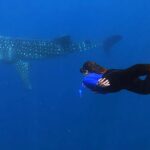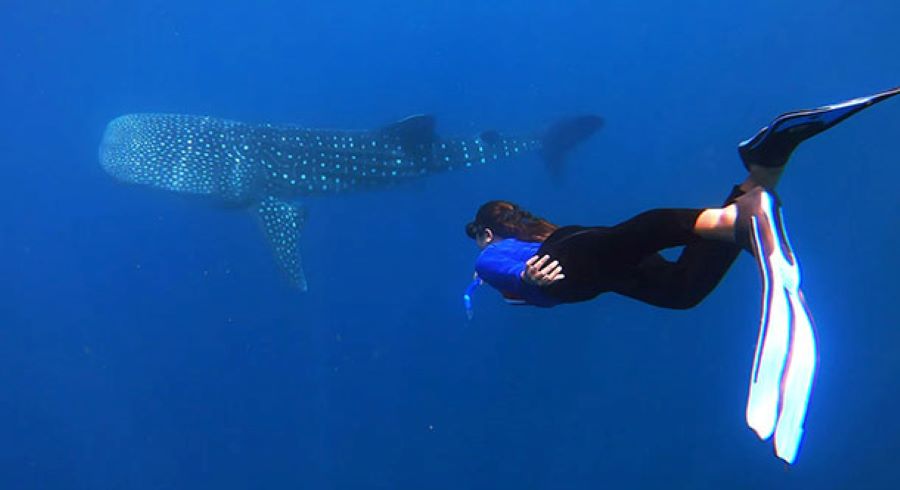Imagine standing on the deck of a small boat in the early morning, the sun rising behind the distant outline of Sumbawa Island. Suddenly, a shadow glides just beneath the surface—massive, graceful, and unmistakably majestic. It’s a whale shark, the gentle giant of the sea. And you’re not dreaming. You’re experiencing one of the most awe-inspiring wildlife encounters in Indonesia: swimming with Sumbawa whale sharks from Lombok.
While Indonesia boasts countless marine wonders, the whale shark encounter in Sumbawa is rapidly becoming a bucket-list item for adventurous travelers. What makes this even more exciting is that you can now experience it on a day trip—or overnight journey—from Lombok, making it more accessible than ever before.
In this article, we’ll guide you through everything you need to know about seeing Sumbawa whale sharks from Lombok: how to get there, the best time to visit, ethical travel tips, and why this adventure is worth your time.
Why Whale Sharks Are So Special
The whale shark (Rhincodon typus) is the largest fish in the ocean, growing up to 12 meters long or more. Despite their size, these creatures are filter feeders, meaning they pose no threat to humans. Swimming beside one is an experience that combines awe, humility, and deep respect for nature.
Unlike other marine creatures that are elusive or shy, whale sharks are surprisingly calm around snorkelers and divers. This makes encounters not only safe but truly unforgettable.
Where Are the Whale Sharks in Sumbawa?
Whale sharks are spotted near the northern coast of Saleh Bay, off the island of Sumbawa, particularly around a traditional fishing area known as “bagan.” These floating fishing platforms attract plankton and small fish—whale sharks’ favorite snacks—which in turn draws the gentle giants to the surface.
The best part? This unique feeding behavior allows for reliable sightings, especially in the early morning.
Getting to Sumbawa Whale Sharks from Lombok
Now to the big question: How do you get to see the Sumbawa whale sharks from Lombok?
There are two main ways:
🛥️ 1. Private or Group Tour from East Lombok
Many eco-tour operators now offer trips starting from Kayangan Port or Labuhan Lombok in East Lombok. From there, it’s a 1.5–2 hour speedboat ride across to Saleh Bay. Tours typically start very early in the morning—around 4:00 to 5:00 AM—to ensure you catch the whale sharks when they’re most active.
These tours often include:
- Transport to/from your hotel in Lombok
- Speedboat ride to Sumbawa
- Snorkeling with whale sharks
- Breakfast or lunch on board
- Optional detours to nearby waterfalls or villages
🛏️ 2. Overnight Trips or Multi-Day Packages
If you prefer a more relaxed pace, you can join multi-day liveaboard or land-based trips that include time to explore Sumbawa Island, visit natural hot springs, and experience local culture before heading out to sea.
Best Time to See Whale Sharks in Sumbawa
The whale sharks in Saleh Bay are present year-round, but sightings are most consistent between May and October. This period offers calmer seas and better visibility, which is ideal for snorkeling and photography.
During these months, several whale sharks are often seen around the fishing platforms at once—making it likely that your trip will be more than worth it.
What to Expect During the Encounter
Swimming with Sumbawa whale sharks from Lombok is generally done via snorkeling rather than diving. The whale sharks tend to stay near the surface, especially in the early morning.
Here’s what a typical encounter looks like:
- Your boat approaches a fishing platform.
- Local fishermen spot the whale sharks and alert your guide.
- You quietly enter the water with a mask, snorkel, and fins.
- Within minutes, you’re face-to-face with a creature the size of a bus.
Expect to spend 15–30 minutes in the water per session, sometimes more if multiple sharks are around.
Is It Safe?
Absolutely—if done properly.
Whale sharks are harmless filter feeders and pose no danger to humans. However, respect is key:
- Do not touch or ride the whale sharks.
- Maintain a respectful distance (at least 3 meters from the body and 4 meters from the tail).
- Avoid using flash photography underwater.
Choose a tour operator that follows ethical wildlife tourism guidelines, and prioritize experiences that benefit local communities and preserve the ecosystem.
Combining the Trip with Other Adventures
Seeing Sumbawa whale sharks from Lombok doesn’t have to be a standalone trip. You can combine it with:
- Rinjani Trekking (if you’re adventurous and want to conquer a volcano)
- Pink Beach or Kenawa Island visits
- Cultural experiences in Sumbawa villages
- Island hopping across the Gilis
The region offers a perfect blend of marine and terrestrial adventure.
Insider Tips for the Best Experience
- Book in advance: Tours fill up quickly, especially during peak season.
- Stay in East Lombok the night before to avoid a very early wake-up.
- Bring your own gear if you’re particular about mask fit or underwater cameras.
- Carry seasickness tablets if you’re prone to motion sickness—it’s a long ride.
- Respect local customs—Sumbawa is more conservative than Bali or Lombok, so dress modestly when on land.
A Journey Beyond the Usual Tourist Trail
Most tourists who visit Indonesia head to Bali, the Gilis, or Komodo—but if you’re looking for something rare, raw, and deeply moving, seeing the Sumbawa whale shark from Lombok might just be your trip’s highlight.
This isn’t just about ticking a box on your wildlife bucket list. It’s about immersing yourself in the quiet grandeur of nature, supporting local fishermen who protect these majestic animals, and creating a memory that stays long after your tan fades.
So next time you’re planning a tropical getaway, skip the clichés and chase giants instead.









